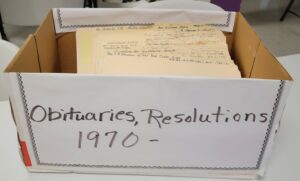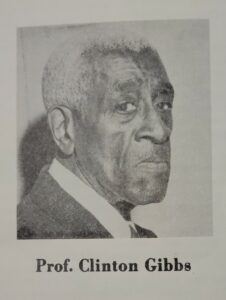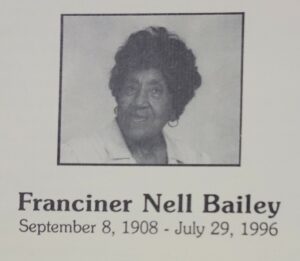
First Baptist Church of Walnut Hills has a large, well-organized and rich set of historical documents. In the process of cataloging the archive, we found a box preserving the obituaries of members whose funerals were held in the late 20th century. Almost every person has a separate folder containing the bulletin of the service with the obituary and a resolution from the Board of Trustees celebrating the person’s Christian life and service. These records reveal how vibrant the church has been and how much it contributed to our neighborhood. Here are a few samples:
The first folder is for Clinton Gibbs (1891 – 1970). His obituary documents his work as organist at First Baptist from 1926 until his death, but also his work at other institutions such as Frederick Douglass School, the Lillian Aldrich Thayer Settlement School of Music, the Cincinnati Chapter of the National Association of Negro Musicians (and many more). Mr. Gibbs is still remembered within the congregation as a piano teacher and choir director. The obituary ends, “The example he set is most worthy of emulation.”

Mr. Gibbs was not the only member of First Baptist who excelled in music. Roland Thompson (1916-1998) played violin in the Cincinnati Civic Orchestra. Estella Rowe (1914-2000; Douglass and Withrow) sang at Music Hall as well as in churches and other concerts. And John Cornelius Sweeney, Jr. (1918-1999; Withrow), while working 2 jobs to support his family, found time to play in jazz ensembles.
First Baptist nourished musical talent through many different groups: The Senior Choir, The Gospel Chorus, The Golden Leaf Chorus, the Mass Choir, and The Inspirational Chorus are named in various obituaries. Children of the church grew up surrounded by opportunities to learn music and caring adults to teach them, in Sunday School as well as Church service.

Civic service was also encouraged and supported. William M. Bolden (1931-2000) was president of the Melrose Block Club and tutored students in math. Susie W. McKnight (1907-1999) was a member of the Cincinnati Federation of Colored Womens Clubs and also served on the Walnut Hills Area Council. Franciner Nell Bailey (1908-1996) was Vice President of the Corryville Community Council and on the board of the YWCA of Walnut Hills. James Arthur Anderson, Sr. (1914-1996) has a Tot Lot named after him in honor of his neighborhood work.
The church honored people for their less prominent but equally important work. Estella Garnes (1914-1997) raised eight children, including a niece and nephew. Leola Echols (1903-1996) was called “grandmother” by many beyond the children of her own 9 children. This amazing lady took up bowling at age 63 while still continuing her work as a cook until age 88. James Richard Butler (1898-1995) and his wife, Wilhelmina Klugh Butler (1903-1995) worked in the church faithfully, singing in the choirs, attending bible studies, ushering, and always there to help out..
Many of these people came to Cincinnati during the Great Migration. The Butlers, for example, were born and married in South Carolina. As a girl, Susie McKnight worked on a farm in Georgia until the owner took her into the house as a domestic. Percy Alexander Reed (1910-2000; Withrow) came to Cincinnati with his parents from Alabama; after high school, he attended Wilberforce, University of Cincinnati and New York City University. He was recognized as a “Living African American Hero” by the Black Male Coalition in 1992. Over half of the people remembered in this archive had been born in the Deep South.
These are only some of the memories lovingly and respectfully preserved by the congregation of First Baptist Church. (Others are pictured here.) The stories of talented, dedicated, kind and faithful members are a significant part of Walnut Hills history, especially of its Black community.
JoAnn Morse